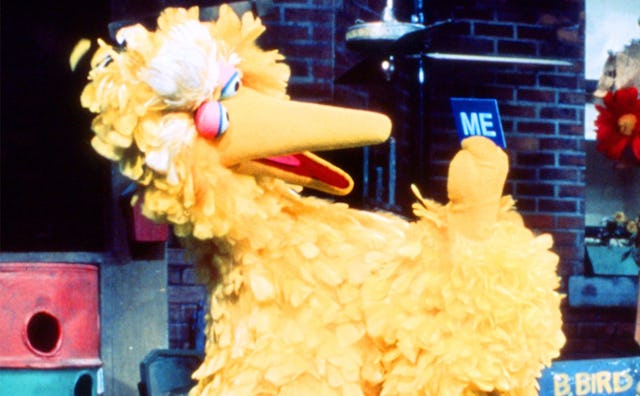6 Important Things I Learned From 'Sesame Street'

Those were formative years. Thanks to Sesame Street, I had a pretty positive attitude about the world I was heading into. City life looked so clean, didn’t it? Those stoops! I really wanted a stoop, and a neighborhood where Muppets, kids and adults walked around, stopping to share a tidbit of information, a puzzle that fascinated them or a song.
I still remember when Big Bird found the “most remarkable word” he’d ever seen, and I can still say the alphabet as one word, the way he did. And the way the Muppets talked to kids was so playful and real; you knew those were real kids talking to Grover, not actors reading scripts with puppeteers.
An article recently came out saying how kids who were exposed to Sesame Street do better in school, and I’m not surprised. I’ll take it to the next level and say that kids who were exposed to Sesame Street do better in life, too, because that show taught me some valuable lessons.
1. People With Everyday Jobs Are Valuable and Interesting
“Who are the people in your neighborhood?” Sesame Street asked this question and gave kids a reason to respect and love their letter carriers, bus drivers, grocers, sanitation workers (then called “garbage men”), firemen, librarians and even telephone repairmen. (Is there still such a thing?)
These weren’t people to take for granted. When I was a kid they all seemed fascinating! And I think it gave me a healthy respect for working people, the ones who keep our society (and our neighborhoods) running. They’re the people that you meet each day!
2. The Alphabet Is Amazingly Powerful
Big Bird discovered the whole thing all at once, but Sesame Street was brilliant at teaching kids one letter at a time, so we could see all the different ways it was used and all the wonderful words that relied on it. My love of language was born there, and I went into kindergarten already knowing how to read, along with some help from my big sister (who would grow up to become a teacher). People talk about how preschool arms kids with the basics before they hit elementary school, and that’s exactly what Sesame Street did. We had personal relationships with each letter of the alphabet, could rattle off a million words for each one, and probably a song, too.
3. Loving Cookies Is Universal
I have always had a sweet tooth, and of course I’m not the only one. When you’re a kid, you don’t understand why adults limit your cookie intake; it seems either totally random or just plain cruel. Why didn’t they understand? Why did they refuse us? Was I weird for wanting cookies so much and so often? Cookie Monster gave a voice to that id in all of us. In his countless game show appearances (with host Guy Smiley), he always chose cookies over fancy clothes or flights, and all he ever wanted from anybody, no matter who they were, was a cookie. Same here!
4. Anything Can Be A Song
The show made songs out of everything, a lovely habit that my parents actually shared. Kids do it all the time—just this morning, my 7-year-old was singing about her new interest in broccoli (a shock to us all). “Rubber Duckie.” “It’s Not Easy Being Green.” “Dance Myself to Sleep.” “I’m an Aardvark.” That aardvark was happy and proud, and he wanted to sing it! If you weren’t a great singer, it didn’t matter, because Sesame Street taught us to sing anyway.
Sing, sing a song
Sing out loud
Sing out strong…
Don’t worry that it’s not good enough for anyone else to hear.
There’s a reason Barbra Streisand recorded that song in 1972, you know.
And even when you couldn’t remember what it was you wanted to sing about, you could still sing:
5. Your Friends Can Come in All Shapes and Sizes
The population of Sesame Street was about as diverse as a place can get. Skin of all colors, fur of all colors, eyes and noses in infinite variety. Some had tails, some could fly, some were just learning their numbers, and some wanted to count all day long (ah-ha-ha!). Everyone was welcome, and everyone had something to contribute to the fabric of the whole.
6. Learning Isn’t a Task, It’s a Game
I still don’t know why schools abandon this concept after kindergarten, but I never lost my love for it, and I hope my kids don’t either. Put something to music, turn it into a game, make a rhyme or a dance to go with it, and suddenly you’re not memorizing information or doing academic chores, you’re playing and remembering the details without any effort at all. We learned how to multiply, how to speak Spanish, the names of all the shapes, how traffic lights work, and how they make everything from crayons to saxophones. None of it was ever boring, and all of it gave us a hunger for more.
You could even learn to count backwards, an amazing discovery for this little guy:
My kids never quite loved Sesame Street the way I did, but they had their moments. When they were younger, we’d sit in front of my computer and watch the old-school videos: Kermit interviewing characters from fairy tales, Oscar singing “I Love Trash,” the aliens who “answered” the phone by making ringing sounds back at it, and Ernie teaching us how to draw Bert’s face. And you know what? I was never a good artist, but I knew how to draw Bert my entire life. Thanks, Ernie.
This post was brought to you by the letter L and the number 6.
This article was originally published on